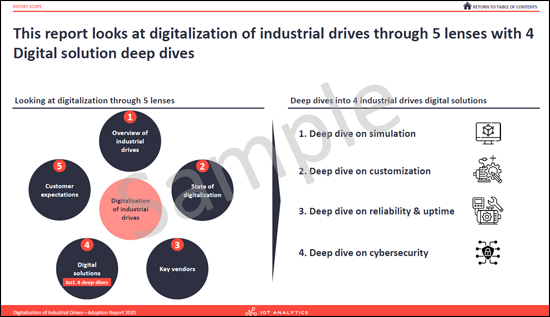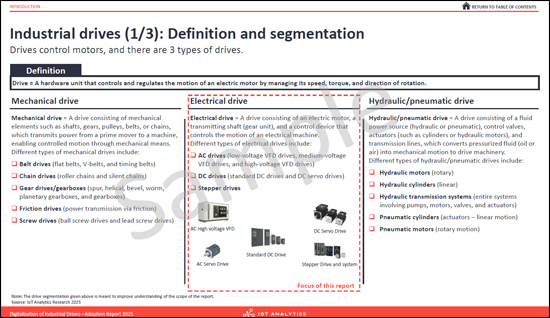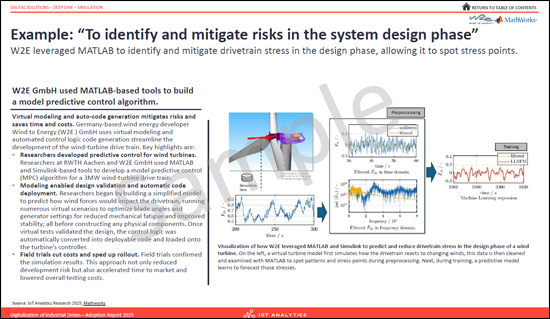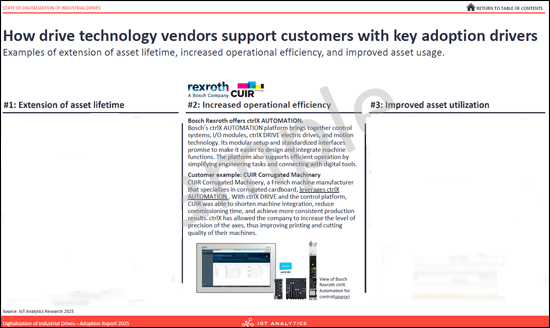|
市场调查报告书
商品编码
1827023
产业用推动器的数位化:引进报告 (2025年)Digitalization of Industrial Drives - Adoption Report 2025 |
|||||||
样品预览


现代工业推动正在从独立组件发展成为互联互通的软体定义资产。这种数位化使用户能够即时监控设备状态、远端调整性能并同时控制多个推动。这项变更为原始设备製造商 (OEM)、系统整合商 (SI) 和最终用户带来了新的机会和课题。
本报告系统性地分析了关键数位化解决方案在整个工业推动生命週期中的应用。报告从五个不同的角度审视市场:工业推动概述、数位化现状、主要技术供应商的趋势、四个数位化解决方案领域的详细分析以及客户期望分析。
本研究包含问卷调查和针对工业推动原始设备製造商和系统整合商的深入访谈。受访者来自欧洲、北美、中东和非洲等多个产业。
样品预览


报告概要
- 157页报告:全面涵盖工业推动数位化解决方案的实施。
- 四大数位化解决方案分析:深入研究四个领域:模拟、客製化、可靠性与可用性、网路安全。
- 涵盖 30 多个产业的资料:涵盖製造业、能源业、采矿业和金属业等众多产业。
- 供应商格局细分:主要供应商依解决方案类型、地区、公司特征和产业进行分类。
- 客户期望模型:详细分析客户对製造商支援和定价的需求。
重点分析领域
- 工业推动概述:提供机械、电动和液压/气动推动的定义和分类,特别关注电动推动。本报告介绍了推动系统的关键组件和典型的软体堆迭。
- 数位化现况:我们按地区、公司规模和产业分析客户的数位化成熟度, 识别数位化应用的推动因素和障碍,并描述原始设备製造商 (OEM) 和系统整合商 (SI) 的客户旅程。
- 工业推动供应商格局:我们按地区、公司特征、产业垂直领域和解决方案类别全面介绍推动相关的数位解决方案供应商。
- 模拟解决方案深度分析:我们分析了整个生命週期中的 11 个模拟用例,考察了所使用的工具类型、采用推动因素、实施课题和可靠性因素。
- 客製化解决方案深度分析:我们考察了 11 个客製化用例和场景,详细说明了客製化方法、采用动机和实施课题。
- 可靠性和可用性解决方案深度分析:我们分析了八种数位可靠性和可用性解决方案,考察如何从推动系统收集数据以及整合外部监控解决方案的课题。
- 网路安全解决方案深度分析:我们评估了 26 个安全框架的采用情况,并分析了这些框架的重要性、采用的推动因素和障碍。
- 客户期望:我们分析製造商在模拟、客製化、可靠性和正常运行时间以及网路安全方面的支援需求,并研究先进数位解决方案的定价预期。
刊载企业
本报告所涵盖的部分公司:
|
|
|
目录
第1章 摘要整理
第2章 简介
第3章 产业用推动器的数位化的现状
第4章 产业用推动器供应商
第5章 数位解决方案详细内容
- 1.模拟
- 2.客制化
- 3.与可靠性运作时间
- 4.网路安全
第6章 客户的期待
第7章 调查手法
第8章 关于IoT Analytics
A 157-page report on the adoption of key digital solutions across the life cycle of industrial drives, based on a survey of industrial drives OEM and system integrators as well as in-depth interviews.
Sample preview


Modern industrial drives have evolved from stand-alone components into connected, software-defined assets. This digitalization allows users to monitor conditions in real time, tune performance remotely, and orchestrate entire fleets of drives. This shift creates a new landscape of opportunities and challenges for original equipment manufacturers (OEMs), system integrators (SIs), and their end customers.
The "Digitalization of Industrial Drives - Adoption Report 2025" provides a structured analysis of the adoption of key digital solutions across the life cycle of industrial drives. It examines the market through five distinct lenses: an overview of industrial drives, the current state of digitalization, the landscape of key technology vendors, deep dives into four digital solution categories, and an analysis of customer expectations.
The research is based on a survey of industrial drive OEMs and system integrators, supplemented by in-depth interviews. The participants were selected across various industries in Europe, North America, and the Middle East & Africa.
Sample preview


Report at a glance:
- 157-page report: Detailing the adoption of digital solutions for industrial drives.
- 4 in-depth digital solution analyses: A deep-dive into 4 industrial drives digital solutions: Simulation, Customization, Reliability & Uptime, and Cybersecurity.
- Data from 30+ industrial verticals: Insights drawn from a wide range of sectors, including various types of manufacturing, energy, mining, and basic metals.
- Vendor landscape breakdown: An analysis of the primary industrial drive technology vendor market by solution type, region, company profile, and industry.
- Customer expectation models: A dedicated analysis of customer requirements for manufacturer support and pricing for digital solutions.
Key areas of analysis:
- Introduction to industrial drives: Details the definition and segmentation of mechanical, electrical, and hydraulic/pneumatic drives, with a focus on electrical drives. It also outlines the key components of a drive system and a typical electrical drive software stack.
- State of digitalization: Analyzes the digital maturity of end customers by region, company profile, and industry. It examines the primary drivers and challenges influencing the adoption of digital solutions and describes the customer journey for both OEMs and SIs.
- Industrial drive vendor landscape: Presents an overview of vendors for drive digital solutions. The analysis breaks down the landscape by region, company profile, served industry, and specific digital solution category.
- Simulation solutions deep dive: Examines 11 simulation use cases across the drive life cycle, including the types of simulation tools used. The analysis details the drivers and challenges for adoption and discusses factors that build trust in simulation results.
- Customization solutions deep dive: Investigates 11 customization use cases and scenarios. It details the various methods used for drive customization, key adoption drivers, and implementation challenges.
- Reliability & uptime solutions deep dive: Analyzes 8 digital reliability and uptime solutions. The section outlines common data collection methods from drive systems and examines the issues faced when integrating third-party condition monitoring solutions.
- Cybersecurity solutions deep dive: Details the state of cybersecurity adoption, including an analysis of 26 different frameworks. It examines the importance placed on various security frameworks and outlines the key drivers and challenges for adoption.
- Customer expectations: Analyzes customer requirements for manufacturer support across simulation, customization, reliability & uptime, and cybersecurity. It also examines customer pricing expectations for premium digital solutions.
A data-driven foundation for key business functions:
- Strategy & corporate development: Inform strategic planning and market positioning with analysis of digital maturity levels, adoption drivers, and implementation challenges across different industries and regions.
- Product management & marketing: Guide product roadmaps and messaging with detailed examinations of digital solution use cases, the vendor landscape, and specific customer expectations for features and support.
- R&D & engineering leadership: Direct technical development priorities with insights into customer journeys, technical challenges, and expectations for simulation models, customization tools, and embedded cybersecurity.
- Market intelligence & competitive analysis: Benchmark offerings and identify market opportunities using the structured breakdown of the technology vendor landscape by region, industry, and digital solution.
Key concepts defined:
- Industrial drives: The report focuses on electrical drives, which are hardware units that control and regulate the motion of an electric motor by managing its speed, torque, and direction. They function as the "brain" of a larger drive system that converts electrical energy into mechanical energy.
- Simulation: The use of software tools to create a virtual model of a drive system. This model allows for testing the drive's behavior under various operating conditions without needing to test on a physical system.
- Customization: The use of specialized software tools to adapt and optimize drive operations according to the unique requirements of each customer, including performance profiles and control interfaces.
- Reliability & uptime: The set of integration-, operation-, and maintenance-related activities that are critical to ensuring the highest level of drive availability and utilization.
- Cybersecurity: The deployment of security measures such as secure boot, encrypted telemetry, access controls, and intrusion detection to defend industrial drives against cyber threats.
Questions answered:
- What are the life cycle stages of an industrial drive and key digital solutions?
- What is the digital maturity of end customers and the drivers and challenges in adoption of digital solutions?
- What are some of the key vendor of drive digital solutions?
- What are some of the "Simulation" solution use cases and the drivers and challenges to its adoption?
- What are some of the "Customization" solution use cases and the drivers and challenges to its adoption?
- What are some of the "Reliability & uptime" solutions and the drivers and challenges to its adoption?
- What are some of the "Cybersecurity" frameworks and the drivers and challenges to its adoption?
- What are the customer expectations from a drive manufacturer?
Companies mentioned:
A selection of companies mentioned in the report.
|
|
|
Table of Contents
1. Executive Summary
2. Introduction
3. State of digitalization of industrial drives
4. Industrial drive vendors
5. Digital solutions deep dive
- 1. Simulation
- 2. Customization
- 3. Reliability and uptime
- 4. Cybersecurity







